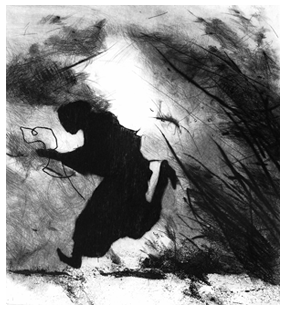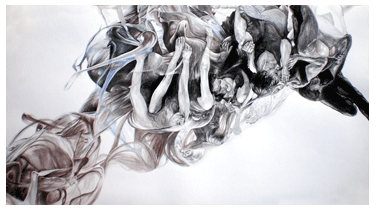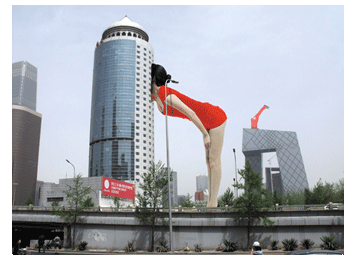- Prelude
- Hard Talk
- New Media
- Rolex : An Overview
- The age of Revivals: Neoclassical Furniture
- Democratization of the Medium No-Budget film: the Indian Context (!)
- Old Sound New Sound
- Decan Odyssey
- North East Opsis
- Russian cool breeze in hot Paris
- Around Kolkata
- Musings from Chennai
- In and around Santiniketan
- In between – from Vadodra
- A Tryst with Art in Madhya Pradesh
- Through the Looking Glass
- The Foreign Connection
- Market Insight
- Market Report
- Artist Index and Statistics
- Auction Reports
- The month that was
- Delhi Dias
- Art Bengaluru
- Mumbai Art Sighting
- Creative Impulse
- Subodh Gupta
- Pooja Iranna
- Preview
- In the News
ART news & views
The Foreign Connection
Volume: 2 Issue No: 9 Month: 10 Year: 2010
| The month of October will see a substantial contribution by six foreign artists coming from different part of the world participating in the coming exhibition GenNext V organized by Aakriti Art Gallery. The following is a brief on them. |
Annabel Schenck
France
Annabel has never invented anything it is always the influence one receives. She only leave traces, imprint tracks of what our common human story has awakened in her and of the images it has conjured up. These pictures are like filtered, clarified through her own look and experience. It's a part of her. She plunged into a new territory, a new space to enrich and extend her understanding of the world.One can't be confined behind borders.
Her work may resemble the transcription into music notes of a familiar tune, at times haunting, plaintive or highly colourful. It encompasses and reflects all that overwhelms her eagerness to translate into something striking. With “Doomed fate”, inspired by her stay in India, she printed on sarees bodies set rigidly in their own garments as if stuck in an accepted plight which they don't fight back.
She projected on pillows the fears of an uncertain future,  the stillness of shots which carry the hopes and the disillusionments of an unknown destiny. This uncertainty is explored through childhood slides cast on swaying pillows where the images come and go like a hurtful memory or a remembrance fraught with bliss. Annabel conceived this work asking herself: “what has this child become?” Each viewer can ask himself the same question. By the way, Pipe dreams, a single-channel video, follows the same idea; It is a performance during which slices of a log, previously carved, are consumed under her eyes, intensely imprints the marks of a thought, of a feeling, of an emotion, of a mood just as they are imprinted on her. When she imprints, a remembered flow of images on light cotton fabric waving behind riddled glass, these are impressions, carved on wood with lines inhabited with visions of ordinary Sundays while living in India.
the stillness of shots which carry the hopes and the disillusionments of an unknown destiny. This uncertainty is explored through childhood slides cast on swaying pillows where the images come and go like a hurtful memory or a remembrance fraught with bliss. Annabel conceived this work asking herself: “what has this child become?” Each viewer can ask himself the same question. By the way, Pipe dreams, a single-channel video, follows the same idea; It is a performance during which slices of a log, previously carved, are consumed under her eyes, intensely imprints the marks of a thought, of a feeling, of an emotion, of a mood just as they are imprinted on her. When she imprints, a remembered flow of images on light cotton fabric waving behind riddled glass, these are impressions, carved on wood with lines inhabited with visions of ordinary Sundays while living in India.
They express and let emerge mental frames and streams that dance within her like under the fans of the room. Today is Sunday. The idea is not only to work a material; when the resulting image is installed, it is moving, evolving behind the opacity of glasses, it disappears, recedes from view then comes back again letting itself be recognized at last, bits by bits; Or it hides behind a log to unveil the untold as in the installation Endoscopy.
The viewer sneaks into the living space as one steps into a painting- the scene consists of an image and all that surrounds it in this place. In that respect, she believes she can't be called a pure “plasticien”, as her images vibrate, breathe while they are set and enhanced in the right context and space which give them their whole significance.
They may trigger thought-provoking recollection or simply titillate the heart and the mind with, some of the emotive or playful flimsiness of poetry.
The viewer connects and identifies to her works because it echoes the world around. I reach him or
her where he or she is: watching, sharing in and catching a glimpse of what we are. Annabel has always kept in mind the powerful edifying words of Albert Camus on the role of the artist. [Art] is a means of stirring the greatest number of people by offering them a privileged picture of common joys and sufferings.
Kaite Helps
United Kingdom
Kaite Helps is an artist based in Lancashire (UK). Born in Bristol in 1987, Kaite went on to study Fine Art at Clitheroe Royal Grammar VIth Form where she received 100% in her Art A level, one of only five people in the country to do so. Kaite continued her studies  at the University of Plymouth and was awarded a First Class Honours Degree.
at the University of Plymouth and was awarded a First Class Honours Degree.
Now a Freelance Artist Kaite's work has been successfully displayed in Plymouth, Bristol, Bath, Sheffield and Lancashire and she even has work in space, aboard the SpaceArc! She is now an International Artist.
Kaite creates her distinctive artwork using homemade paints. Trained in making oil paints Kaite has moved on to making watercolours to have a more fluid medium. She now makes the paint out of spices and powders bought on her travels around various parts of the world. When painting with her handmade watercolours there is unpredictability in how the paint will react with the surface and how the colours will evolve over several days. This is something that Kaite has had to learn to take into account when developing her paintings and it adds an unusual quality to each piece.
The work being displayed at Gen Next V Exhibition has been painted onto Saffron dyed cotton with watercolours made from Paprika, Turmeric, Indigo and Vermilion powder, the latter bought from Jaipur, with a touch of graphite. The painting was inspired by her travels to North India and South East Asia during the first 6 months of 2010. The inspiration gathered from her travels came be clearly seen within the painting which represents temple architecture and religious objects such as lotus buds and prayer flags.
Laura Guoke
Lithuania
In her recent work attention is paid to the significance of deconstruction ideas to the art of graphics, identification of separate creative attitudes, necessity of an identity as the analysis of philosophical problem as well as fluctuation of depiction characteristics.
 The most important topics: identity, body as a model of subjectivity, deformation, depersonalisation.
The most important topics: identity, body as a model of subjectivity, deformation, depersonalisation.
One of the general objectives of her work is to deconstruct an identity, to “depersonate” the body. Image of a person is the central axis on which the reality of graphic works is being modelled and realised. The body is as a creative link in hyperspaces of the functioning new media. On one hand, the body in prints is approached as some specific body of a general social formation, a formation reflecting the topic of late postmodernism. On the other hand, the body becomes a model of subjectivity, of which field of concepts is being constantly expanded and used in a metaphorical sense. The today's reality is experienced in a form of separate events, associative objects and therefore the image of a person as a pure object is not defined in prints. Single references to signs become important to the process of knowledge of identity and perception of meaning which can be understood as the difference in personal identity. Personal identity is defined by different aspects, i.e. graphics become one of the signs with the help of which the representation of identity is created. It locates everything that is created by the latter, it becomes the image of an image, even more that a postmodern concept of personal identity also emphasizes a possibility to create it with the help of discursive signs, when including a spectator of the creation into the continuous process of play. Person and his identity, society and its interrelationship with a person having become rather relevant, provoke creators to change their attitude towards their creative search while looking for contact points with what surrounds them and forms the identity. Person and his environment are perceived as much as they are fragmented and constantly changing particles of the whole. Not only the world but also the attitude to the latter are fragmented by means of experiences and expressions and such fragmentation becomes an artistic code.
Yu Zhaoyang
China
“Ostrich” was always called as the name of “weakness”, it will hide itself by lying flat against the ground once hreatened.If compare people with the ostrichs, maybe many people will think it is a big jok. But there is some subtle similars between people and ostrichs. The significance of art is going directly into the viewers'hearts through visual impact of the artworks, making you know the truth in the moment. “Metropolis Ostrich Series” brings us this kind of alert.
In Yu Zhaoyang's “Metropolis Ostrich Series”, we can see the wonderful visual impact of metropolis and ostrich. The city girls who dressed in warm red in front of the modern architecture of city symbolic have unseen their ture faces. And in this city (Beijing) which has rich history, but modern material desires has concealled the contents of city itself.  As long as the person who has single and sincere heart, his trueness can not move a single step in front of infinite desire.
As long as the person who has single and sincere heart, his trueness can not move a single step in front of infinite desire.
No matter how high the buildings are, they can not higher than people's desire; no matter how prosperous the cities are, they can not resist to the keeping sad and dreary of people's heart; and no matter how rich the material is, it can not cultivate the people's true smile. What is the feeling of the urban men and women under their busy paces? Watching the photographs “Metropolis Ostrich Series” from the Chinese artist Yu Zhaoyang, we seem like finding the physical resonance. Similarly, we all conceal the helpless behind our smile, concealing the terrified behind our confidence. Most of people think themselves like the men if they with the other people, but liking the dogs if they are behind them. Men have their pressure, and women also have their helpless. But “respectable” is Chinese typical character, they all think they should “Wash the dirty linen at home”. So pretending nothing happened before the other people. It makes no way to giving utterance to the former pressure. Only can be an ostrich, imaging they can see nothing, bothering by nothing.
The modern people whose exterior are flamboyant, but their inner is abnormal weak. People try to make themselves reach a agreement with the environment under their full of material desire surface. So they pack themselves at all cost, their heart were steeled. Costume, luxury goods, high-ranking houses and cars, these are all the best materials to pack people themselves. So people try their best to get these things. Their genuine hearts are changing all the way. Maybe it is the demand of modern materials.
No matter in any times, the Ostrichs are existent. So good artworks always are not the dependence of the technology, they should be the creaters of the life and thoughts. Yu Zhaoyang with his own unique visual angle restore many modern people's living conditions.
Francesca Ramello
Italy
Francesca graduated in Cuneo(Torino) in 1994.She started working as a decorator and designer. From 1994 she has been doing various art exhibitions. Her works expresses the confusion which invades the world where peoples are suffocating throughout schemes that they created and forgotten to give space to their internal universe, realizing that they have muffled their instincts to collapse into a materialistic and illusory world. The repression of human's foolishness, of their own instincts and emotions as a consequence is the best solutions and violence and maladjustment is the direct result of it.
In this part her artistic work is created always with two similar subjects but in two different psychological conditions.
There is humanity attacked by diagrams (a symbol of an artificial universe, of an order in disorder), a humanity in  black and white but smart enough to rebel against (the scream is a positive act, awareness of discomfort, desire to escape from a stiffing mood).
black and white but smart enough to rebel against (the scream is a positive act, awareness of discomfort, desire to escape from a stiffing mood).
In contrast there is colorful humanity in touch with its primal instincts (the flowers always express emotions, meeting with our inner self).
The conceptual idea of this work invites the people to live emotions of the represented characters and since we recognizes our own scream we legitimizes our inner rebellion.
The work chosen to exhibit is the next step after the scream, after the rebellion, it's the time of metamorphoses (Kodai in Metamorphosis, sculpture), the moment of reflection and the reconciliation with our emotional universe but it's also the moment of astonishment in front a new life in a changing world. The grotesque caricature of a new humanity without race, dared in front of a new evolutionary process unfortunately destined to create a new breeds.
To represent the humanity she describes and created two characters named Kodai & Kodo. She wanted to create two almost cosmopolitan figures to contrast the phobic hypocrisy of our breeds perennially in contrast to predominate one on the other.
Race is a mental construction, however the science established methods of rating individuals on the basis of physical appearance and the cultural distinction to create the concept of racial identity, Kodai and Kodo are undressed from social and cultural connotations, they present minimum physical characteristics that may define a breed (hair, clothes...), they are deliberately lean (the sexual distinction between man and women is recognized only in few physical characteristics) and they have a physiognomy that is supposed to be a future humanity that changes according to the changing world in which they live.
Her works represent a new humanity born from the metamorphoses of previous races which have evolved from larval stage into a new being.
Arsalan Naqvi
 Pakistan
Pakistan
Arsalan has done 4 years Diploma in Fine Arts from Khana-e-Farhang Cultural Centre of Iran. He has participated in several big shows in Pakistan over a period of time. His first solo exhibition was held in the year 2008 at Alliance Françoise in Karachi at Pakistan. His works were showcased in the group show this year that is 2010 at Grandeur Art gallery, Karachi. There were two major group exhibitions where Arsalan has participated in 2009 and was highly applauded. They were held at Indus Art gallery, Karachi and at Gallery 6 in the capital city of Islamabad. He has also attended a few workshops in this small span of his professional career.